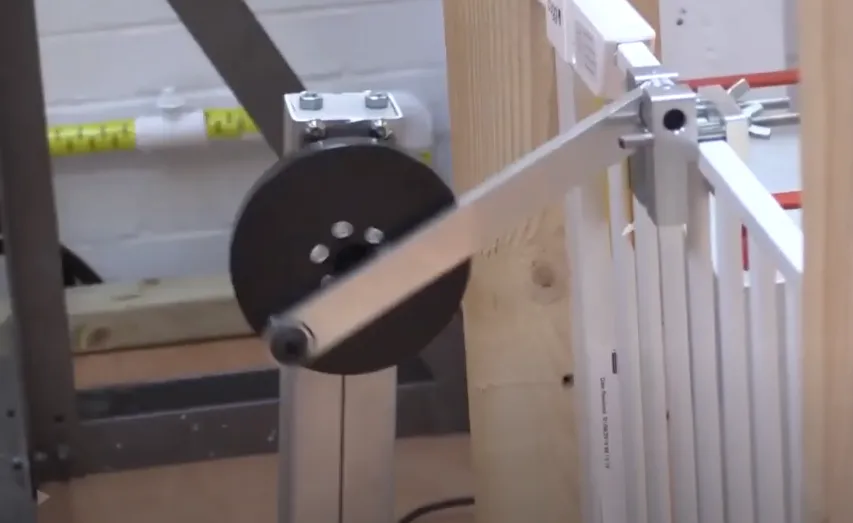BS 5852 Flammability of Upholstered Children’s Furniture Testing
The British Standard BS 5852 is a comprehensive framework for assessing the flammability characteristics of upholstered furniture intended for use by children. This standard ensures that the products meet strict fire safety requirements, which are crucial in preventing potential hazards and ensuring child safety.
Under this standard, tests are conducted to evaluate how quickly a material ignites when exposed to an open flame source, its rate of burning, and the production of smoke and toxic gases. The primary focus is on upholstered furniture such as cots, beds, and rocking chairs designed for children under 36 months.
The testing process involves several critical steps:
- Sample preparation: Samples are cut according to specified dimensions to ensure accurate measurement.
- Test setup: Specimens are placed on a metal tray with an appropriate flame source positioned beneath them.
- Data collection: The duration of ignition, the rate at which it spreads, and the intensity of smoke and gas emissions are recorded.
The results from these tests provide manufacturers with valuable data to improve product design and ensure compliance. This standard is pivotal in ensuring that furniture products meet the stringent fire safety regulations set forth by regulatory bodies like the UK's Department for Communities and Local Government (DCLG).
Companies investing in this service can expect detailed reports, which include:
- Quantitative data on ignition time.
- Visual records of flame spread behavior.
- Analysis of smoke density and composition.
The rigorously conducted tests under BS 5852 not only enhance product safety but also contribute to a safer environment for children. This standard is widely recognized, ensuring that products meet the highest international standards.
| Test Parameters | Expected Outcomes |
|---|---|
| Ignition time and flame spread rate | Documented data indicating compliance with specified limits. |
| Smoke production and gas emissions | Analysis of smoke density and composition, ensuring minimal toxic effects. |
The BS 5852 standard is a cornerstone in the furniture industry, particularly for manufacturers of children’s furniture. It underscores the importance of fire safety and helps ensure that products meet stringent regulatory requirements. By adhering to this standard, companies can enhance their reputation for quality and safety.
Scope and Methodology
The scope of BS 5852 testing is specifically tailored to upholstered furniture intended for use by children under the age of three. The methodology involves a series of standardized tests designed to evaluate the flammability characteristics of these products. The primary objective is to ensure that the materials used in manufacturing meet strict fire safety standards, thereby reducing the risk of fire-related incidents.
The testing process begins with the selection and preparation of samples from various types of furniture such as cots, beds, and rocking chairs. These samples are then subjected to controlled flame exposure under specified conditions. The duration and intensity of the flame are carefully regulated to mimic real-world scenarios accurately.
Data collection is a critical component of this testing process. It involves recording the time it takes for the specimen to ignite, the rate at which the fire spreads across the surface, and the amount of smoke produced during the test. This information is vital for understanding the behavior of different materials under flame exposure.
The results from these tests provide manufacturers with valuable insights into the flammability properties of their products. By analyzing the data, companies can make informed decisions about material selection and design modifications to enhance product safety.
Industry Applications
The BS 5852 standard is widely applicable in various sectors of the furniture industry. It ensures that children’s furniture meets stringent fire safety standards, protecting vulnerable populations and ensuring compliance with international regulations.
- Furniture Manufacturing: Manufacturers can use this service to ensure their products meet regulatory requirements, enhancing brand reputation and customer trust.
- Retailers: By offering products that pass BS 5852 testing, retailers demonstrate a commitment to safety and quality, attracting more customers.
- Regulatory Bodies: Compliance with this standard is mandatory in many regions, making it essential for oversight agencies to ensure product safety.
The table below highlights the specific applications of BS 5852 testing across different industry sectors:
| Sector | Application |
|---|---|
| Furniture Manufacturing | Ensuring product compliance and safety. |
| Retailers | Showcasing commitment to customer safety and satisfaction. |
| Regulatory Bodies | Mandating compliance with international standards. |
The competitive advantage of adhering to BS 5852 lies in the enhanced reputation for quality and safety, which can significantly impact market share and customer loyalty. By offering products that exceed regulatory requirements, manufacturers set themselves apart from competitors, establishing a strong brand identity.
Competitive Advantage and Market Impact
Adhering to the BS 5852 standard provides numerous competitive advantages for furniture manufacturers. By ensuring that their products meet stringent fire safety standards, companies can differentiate themselves in a crowded market. This commitment to quality not only enhances brand reputation but also fosters customer trust and loyalty.
- Enhanced Reputation: Compliance with international standards reflects a company's dedication to product safety and quality.
- Informed Decision-Making: The detailed testing process provides manufacturers with valuable data for improving product design and functionality.
- Customer Trust: By offering products that meet regulatory requirements, companies can build strong relationships with consumers.
The market impact of BS 5852 compliance is significant. It ensures that products are safe for children's use, reducing the risk of fire-related incidents and protecting vulnerable populations. This standard also plays a crucial role in shaping industry trends and driving innovation in product design and materials selection.
By ensuring compliance with this standard, manufacturers can stay ahead of regulatory changes and market demands, positioning themselves as leaders in safety and quality. This not only enhances their competitive edge but also contributes to a safer environment for children.





